Disclosure: Meeple Mountain received a free copy of this product in exchange for an honest, unbiased review. This review is not intended to be an endorsement.
If you have a chance to review any of my previous content, you’ll see a lot of glowing words attached to the reviews of games designed or co-designed by Simone Luciani.
To me, Luciani is gaming royalty. Grand Austria Hotel, Lorenzo il Magnifico, Marco Polo II: In the Service of the Khan, and Tzolk’in: The Mayan Calendar are some of the best games I have ever played. Luciani’s “T” game release with Daniele Tascini, Tiletum, was my pick for the best game of 2022.
With all of that in mind, there was never a doubt that I would play Anunnaki: Dawn of the Gods (2023, Cranio Creations), a co-design with Danilo Sabia. Sabia and Luciani also designed Rats of Wistar, which will soon make its way to gamers in the US.
I’m not going to lie to you: Anunnaki didn’t hit it out of the park, to use a baseball reference. It’s not that the game is bad—in fact, it is occasionally interesting, particularly with its action selection mechanism—but it is very likely that my standards for Luciani games have gotten too high. Grand Austria Hotel is the best Euro-style game I have ever played; as a film buff, when you love a film director and that director puts out middling fare, you notice.
Anunnaki is OK. But what really shocked me was the quality of components in the box. The team at Cranio was kind enough to provide a Kickstarter Edition copy of Anunnaki for review during our SPIEL 2023 visit, mainly to have a chance at the expansion content. But this is the least deluxe version of a game I have played this year, which speaks to the standards of what it means to say “deluxe” on your game’s packaging nowadays.
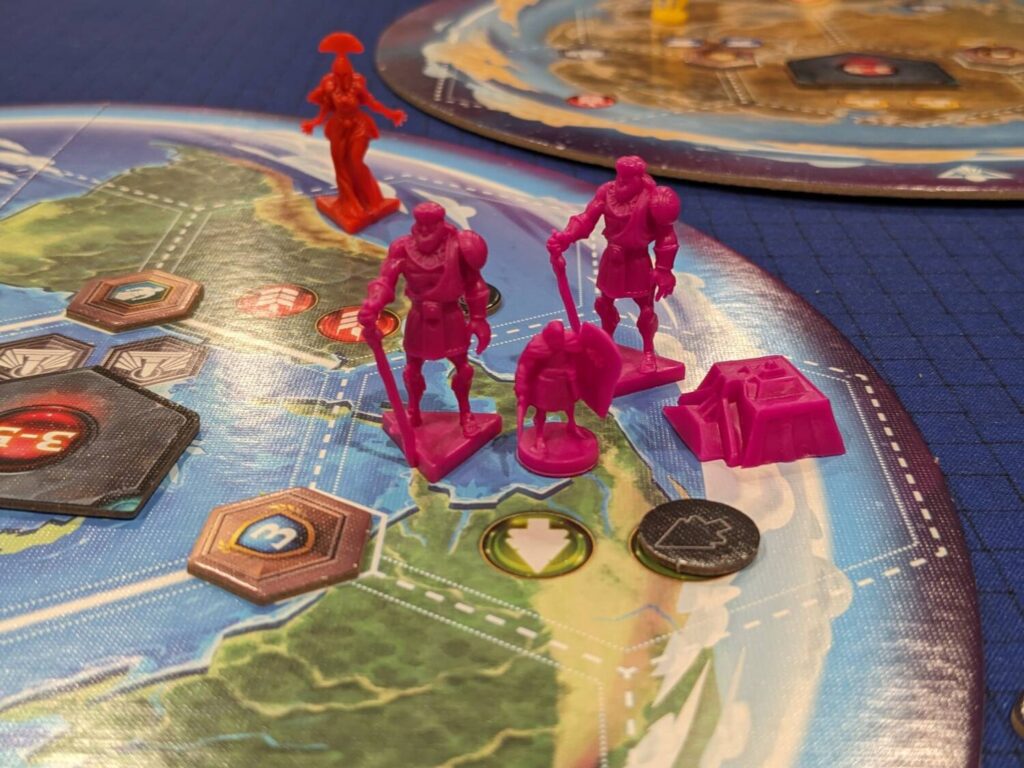
The Game: It’s Not Voidfall
Anunnaki is a “4X”-style game for 1-5 players. Over a series of rounds, players take on the roles of civilizations in “an ancient dystopian past” to fight other civilizations (both player-run and AI-driven), explore the planet where they reside, harvest territories for resources, and fulfill contracts to move up technology tracks.
Unfortunately, Anunnaki is delivering in a year when a significantly better version of 4X-style Eurogaming has already hit…and that game is Voidfall. Plus, while Scythe was the reference point other players mentioned most during my plays of Anunnaki, even this year’s earlier Scythe-style production Brazil: Imperial was a better, cleaner fit for the growing “3.5X Euro” category.
(Here’s the current definition of my made-up term “3.5X Euro”: games that feature a mix of the three non-”eXterminate” Xs—eXplore, eXploit, eXpand—in an environment skewed heavily towards engine-building and mostly, if not completely, deterministic combat. The “.5” is a running reference to the idea that opponents can’t really be exterminated from the game’s map, which feels like something newer to ensure players don’t have to rage-quit because they are no longer able to quickly deploy armies to the map. Scythe is the best example of this, or at least it was to me until Voidfall released. Other games I have played in this vein include Brazil: Imperial—itself a Scythe clone—Last Light, and The Warp. I added Euro to the name because most of these games seem to push people away from direct interaction/conflict instead of towards it, standard for games that feature multiplayer solitaire puzzle solving in other Eurogames.)
Anunnaki misses the mark when compared to other titles. That starts with the game’s theme. In the base game, players pick from one of four factions led by characters you might know from various mythologies: Zeus, Odin, Ishtar, and Ra. Your population, composed of followers, minor gods and your major god, must move across hexes on both your home planet and the planet Gaia, a shared planet board that features the opportunity to control the Lost City of Atlantis and the powerful shrines that exist there.
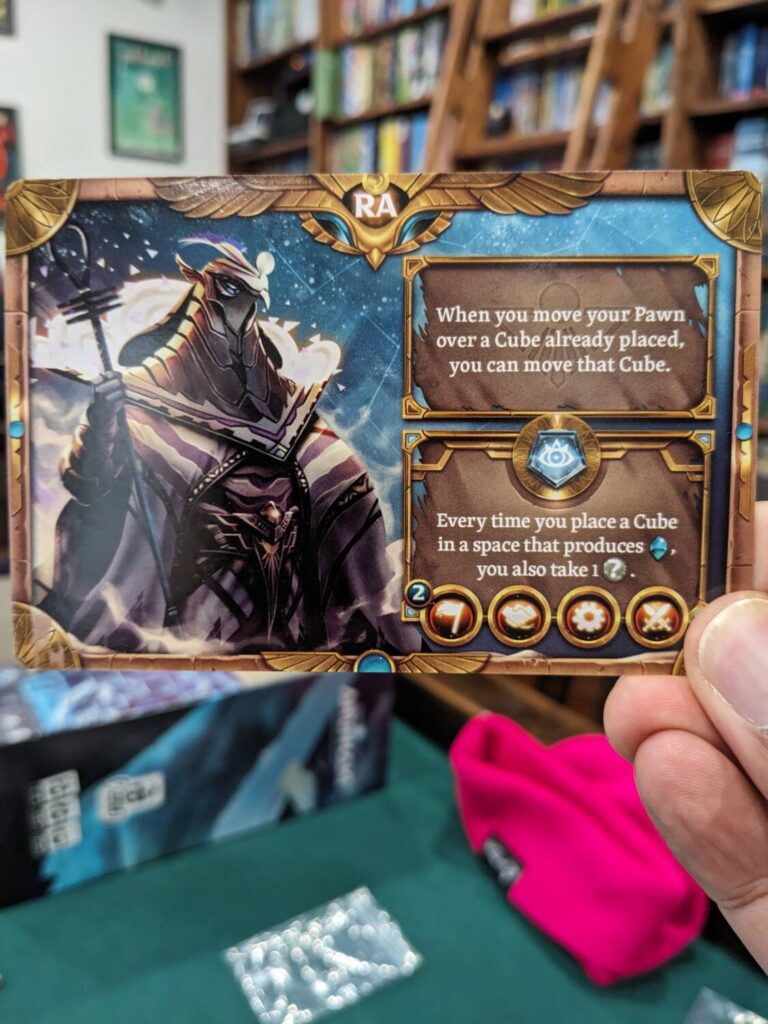
Each player’s turn in Anunnaki has a lot of possible steps, but the beginning of each turn is dictated by an action wheel. Players move a pawn from point to connected point, dropping Summoning Cubes over empty spaces along the way. As certain portions of the player board become surrounded by these cubes, a minor or major god could be summoned, which changes the powers, scoring and rules for that specific faction. Some of the powers are interesting—harvesting can be upgraded, combat rules changed, maybe movement range is increased.
After taking a main action, turns can be extended through the use of mana crystals to do things like additional minor actions, completing contracts (known as “Commercial Pacts”) and activating new gods. Combat takes place on hexes where movements end amongst enemy factions. In an interesting twist, the eXplore “X” of the 4X formula comes at the end of a turn in Anunnaki, with the discovery of Culture tokens only when all three hexes surrounding a resource token are controlled by active players.
So, the guts of what should happen in a 4X game are here, there are variable player powers, and there are Euro elements like progression tracks too. It’s not a perfect fit, but there are a few fun things about turns in Anunnaki. Two of the factions—the ones led by Odin and Ishtar—are more interesting than the others. Odin’s faction has the ability to relocate settlements. In a nod to one of my favorite games from last year, Circadians: Chaos Order, Odin & Co. are essentially mobile headquarters that get to have fun doing quick-strike attacks all over the map. Ishtar & Co. have settlements that can produce at double the strength of a follower, so eXploit actions are fancier with that faction.
The group led by Zeus seems to push a player towards simply being around on all of the planet and Gaia boards in the game, thanks to an increased ability to eXploit discovered resources. Ra’s power is to keep moving its Summoning Cubes around, if anything to close off the routes of the action wheel to activate gods faster and to maximize mana crystals for use on bonus actions.
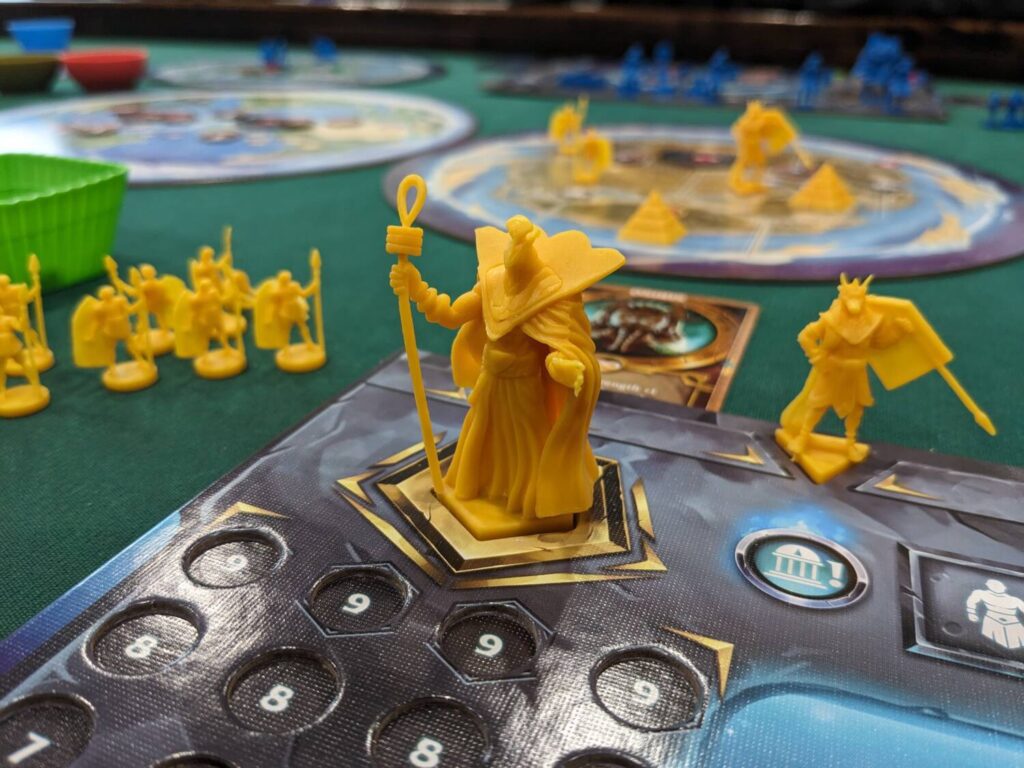
Insert Thrills Here
What surprised me the most about the mechanisms in Anunnaki: none of these feel particularly clever, at least for a Luciani design.
The primary action on each turn is to use your “Action Pawn” to move from one tile to the next, taking one of about eight distinct actions (two actions appear twice on the wheel: move and harvest). You move your pawn and you do a thing.
Dropping cubes is why this should sing—and the depletion of a player’s Summoning Cubes is one of two possible end-game triggers—but dropping cubes didn’t excite me. It doesn’t help that a few of the actions on the wheel are so simple. One is simply “take X resources times the number of shrines under your control.” But that resource is the one your home territory produces already. Another is a market action tile—trade one resource for two other different resources.
The bonus actions are things like building settlements, or adding troop strength. Strangely, there is not an action on the primary wheel to build settlements, which allow a player to have more deployment points for their followers. Why? Building structures is core to every other 4X game I can think of…but here, it’s a bonus action.

Upgrading actions provides a chance to take that upgraded tile’s action; cool. But resources are so exceptionally tight in this game thanks to the tight rules around harvesting that doing a bonus action or fulfilling a Commercial Pact (some of which require four resources to complete) can sometimes feel like a minor miracle.
Anunnaki often feels like Just Another Game, which is shocking to me given the designer pedigree. It was also surprising to see the game come off as a bit of a point salad when games ended. In both of my multiplayer plays (both at three players), everyone took wildly different paths to achieving their objectives.
In each multiplayer game, players all scored in the 70s, with no one ever winning by more than three points. (I also tried this once solo.) It just seemed like nothing we did was distinct, or overpowered, or total genius. The game was played, the game ended, we went about our lives.
So, Anunnaki as a collection of game mechanisms was OK. But as a production? I have serious questions.
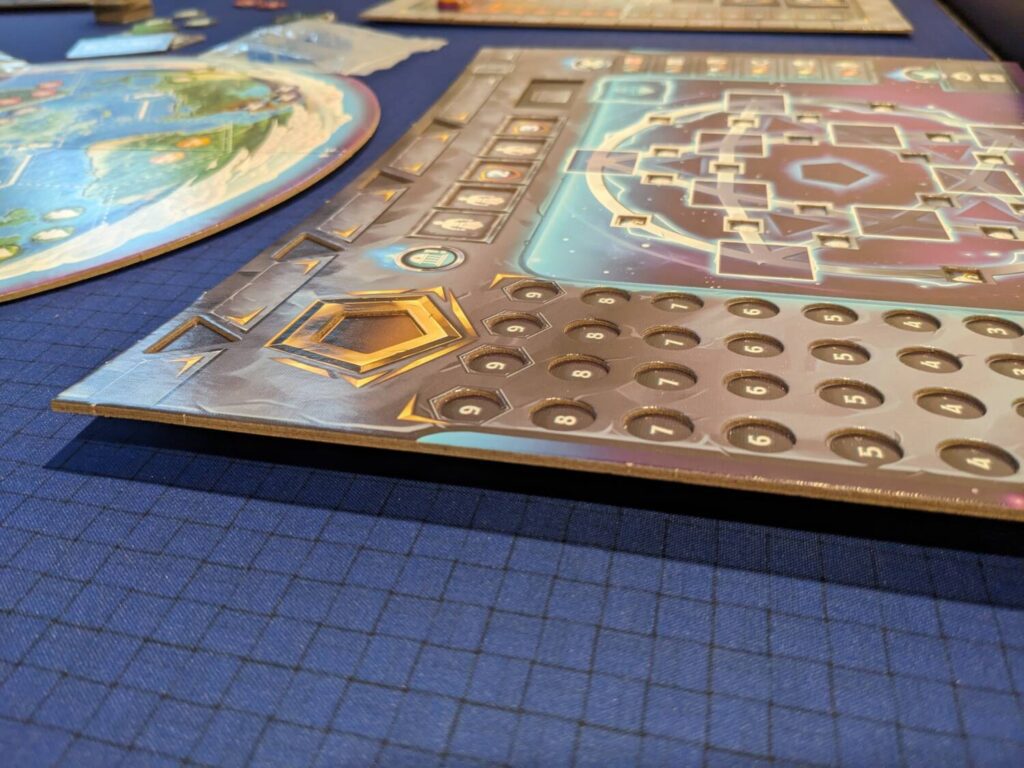
“The Warp” is Right
The Kickstarter version of Anunnaki certainly feels like it is labeled as a deluxe edition. Again, I’m coming off a month where I opened up the granddaddy of ridiculous 4X deluxe edition games in Voidfall. Voidfall is deluxe in every way, from upgraded triple-layer player boards to metal guild tokens to plastic ship miniatures, plus, it has a storage solution to die for.
The people that manufactured Anunnaki’s Kickstarter Edition should spend time studying what Mindclash’s manufacturers did so well.
The player boards here are abysmal. Within 24 hours of opening the box, the player boards (which hold the action tiles, god miniatures, resource trackers, and mana crystals) were so warped that one of the gods in the left-most spot on my board was constantly tilting over. The planet boards are mostly intact and not warped, but the five player boards are so bent I have to consider trying to bend them back at risk of damaging the cardboard.
The miniatures here feel cheap…really cheap. So cheap that parts of two of the Ishtar followers have already fallen off. The plastic feels really thin, and many of the miniatures were bent out of shape when standing on a flat surface BEFORE my first play. The settlement tokens for each faction are great, but the followers and god tokens are just not acceptable.
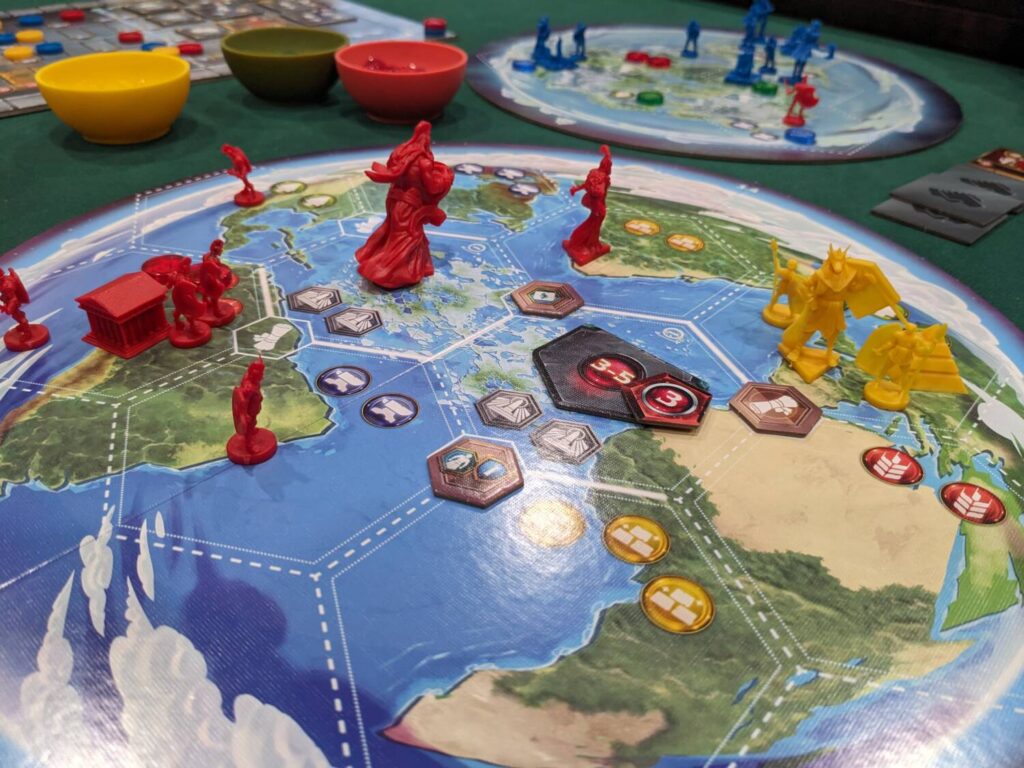
One of the strange misses with the player board: there are sunken, inset spaces to hold the gods, the Summoning Cubes, and the resource tracker tokens. But the main action area has tiles that move around a bunch. Why are there no inset/sunken spaces to hold those cardboard tiles?
The card stock is fine, the mana crystals do the job, and I can even work with the cardboard chits that denote harvested resource spots on the planet and Gaia boards. But putting all of this stuff away? The storage solution here is poor. There’s also a lot more space across the five trays of stuff than needed, and there’s a good amount of space between the top tray and the inside of the box cover, even after reinserting the instruction manuals, maybe a half-inch. That almost guarantees that the box cover will sink a bit if I try to store other items on top of this on my shelf. Why was this box not sized differently?
One positive highlight of the production: the rulebooks. There are five in the Kickstarter version of the game, for expansions, solo, and the main game. The rules do an excellent job of describing how to play. I would argue that this is one of the most concise series of rules given the weight of a game I have played all year. Unfortunately, as great as the rulebooks are, the “player aid” is basically a three-inch cardboard tile that doesn’t really tell players anything. It has symbols for the five steps that are possible to take on a turn. A player aid would save people like me, responsible for teaching heavier games, from having to re-teach the game so often during play.
I have never previously had issues with Cranio’s retail releases, so all of this was a major shock to me and my groups when we went through the box. I really feel for Kickstarter backers who opened this package up and experienced any of the things I went through.

Disappointing
Anunnaki is a miss. It’s not a bad game, but when compared with other 3.5X Euro games in 2023 alone, it falls a tier or two below some of the games I’ve referenced in this article.
Luciani’s other designs this year, including Darwin’s Journey (a game that I thought was only OK), had something mechanically to hang their respective hats on. In Rats of Wistar, it was that incredible tension with the action wheel. In Nucleum, the double-sided action tiles really shine.
In Anunnaki, I’m not sure what that is. It’s not the tracks or the combat system. The god powers are interesting but nothing to write home about. (It’s also not the god choices; there are only four in the base game.) And for the reasons highlighted above, I can’t recommend Anunnaki as a production.
For Luciani completionists (i.e., me), you should try Anunnaki just to see for yourself if this game will be a fit or not. It’s not on the level of his previous work, but this is also the first attempt I can think of doing a 4X-style game.
There’s not much to recommend here. The greats always miss from time to time, and I’m chalking Anunnaki up as a game that needed more time in the oven. I’m already looking forward to Luciani’s 2024 release slate.


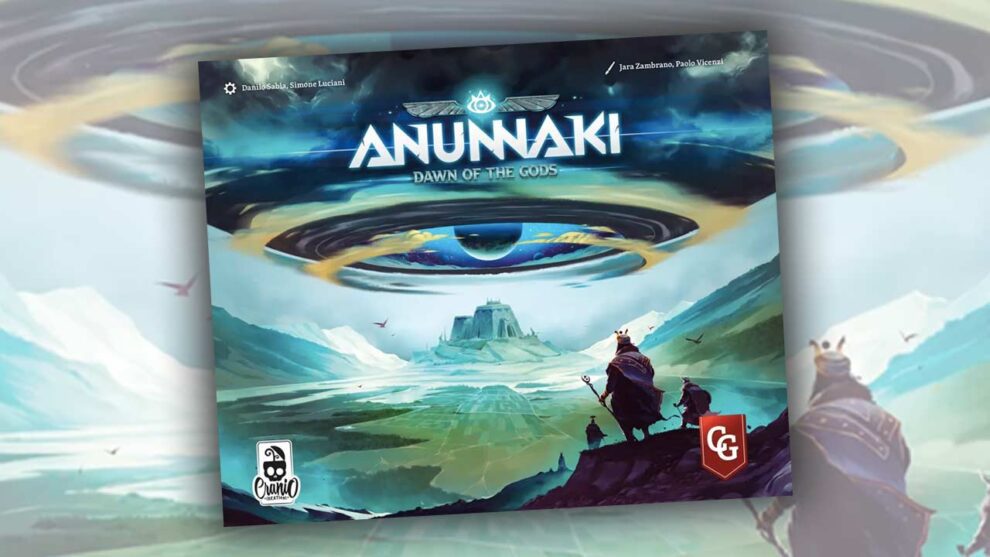









So sorry this was a miss. A sub-par product from a beloved designer can feel tough. Just as it can for a sub-par film from a beloved director.
I hope 2024 is better for Luciani.
That said: great review.